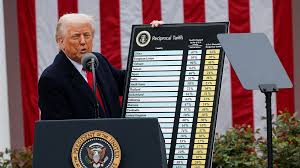The US apparel manufacturing industry has had a long and rough decade. Ever since the 1980s, the industry’s employment and productivity have declined by over half from its peak in 1979. With Donald Trump’s trade war against global manufacturing giants, many US apparel brands might reconsider their manufacturing strategies. They might be thinking of returning to domestic manufacturing. But is it worth going back to US manufacturing? Would it save both brands and these industries in the long run, or will adjusting to Trump’s constantly shifting trade tactics cost both of these parties more in the long run?
The answer is difficult and nuanced, and there’s no way of knowing what will happen in the future. Within the first two weeks of April 2025 alone, the US government went from enacting reciprocal tariffs on nearly every country on Earth (even those with only penguins) to delaying the tariffs but enforcing a 145% tariff on China alone.
Any brand making major decisions in rebuilding factories in the US would be blindsided by the sheer speed of this news, fast enough to completely change calculations before ink has dried on any contract.
So let’s break down some things to consider when choosing your next steps as an apparel brand, whether you’re investing back into the US or searching for new overseas partners:
1. Costs
Obviously, before the tariffs, it was widely accepted that overseas manufacturers were generally much cheaper than US ones. Bulk orders for t-shirts in the US can go for as much as $17.50 per tee, whereas Chinese manufacturers could make it for $13.14, and Bangladeshi manufacturers for as little as $8.55.
With the increasingly ludicrous tariff rates the US has imposed on China (now hovering over 145%) and possibly many other countries, some of these prices will be less worthwhile now than going to a US manufacturer. However, lower-cost manufacturing countries like Bangladesh and Vietnam may still be cheaper overall even after the 90-day tariff delay.
So many apparel brands will still look for overseas manufacturers, except now they’re more expensive, and either the brand or the customers have to bear the costs. Even the apparel brands that move back to the US manufacturing industry will still have to adjust to the higher price adjustments within the country.
That also brings a second issue:
2. Availability
According to the US Fashion Industry Association, over 72% of fabrics are imported into the US, and over 98% of all clothing in the US is imported. The current US apparel manufacturing industry has shrunken by 90% due to a decreased competitive labour force and a lack of raw materials. Both of these seem like obvious problems the US government are trying to solve through tariffs–easy, right?
Not quite. Because of the sheer reduction of labor and raw materials, even currently existing US textile manufacturers are dependent on foreign imports to continue running, whether its for fabric, machinery, or otherwise. So once tariffs come into play, even these domestic manufacturers will get hit, leading to a situation where they will need to raise their prices.
Studies have already estimated that US manufacturers needed to pay 62% more for raw materials in March, leading to a 5.5% price increase overall. In other words, the tariffs have made US manufacturing prices slightly less competitive, even compared to the currently hammered overseas markets.
Even if you thought it’d be more worthwhile to invest in American manufacturing, the few remaining manufacturing companies may not be enough to support the current demand. It’ll take years to build a more stable internal supply and production chain. And those tariffs are impacting your business now, not in many years.
Which brings us to our final point:
3. Uncertainty
In the week we’ve researched for this post, Trump has gone from announcing 37% tariffs on China to a total of 104%, and then later 145%. The stock market has gone through a repeated process of crashing and rallying; there’s a new major shock every single day, and no one in the industry knows what’s going to happen next.
If you’re a brand, both continuing to invest in certain overseas markets and moving back to the overburdened US markets is equally unstable ground. It doesn’t matter whether or not you can afford it. Deciding to fully invest in one or the other can be shaken completely be a new executive order, a complete tariff withdrawal, a new tariff policy, or any other moment in politics.
In simpler terms: setting your heart on any kind of manufacture is a gamble, no matter.
4. Solutions
So what can you do if you’re a poor, burgeoning apparel brand in the US? Right now, we’d recommend double-checking your supply chains. If you’re looking to invest in US manufacturing, prioritize partnering with more advanced forms of apparel merchandising. The added quality and labor force from the US market may give your brand a competitive edge in apparel sustainability and luxury.
Manufacturers in China might be in deep water, and some of the other ‘cheaper’ options, like Bangladesh and Vietnam, may still be affected by tariffs if no negotiation is done post-90-day tariff delay.
Something interesting that’s been shown is that certain countries were not as heavily impacted by tariffs as others. Brazil, Egypt, and Singapore, for instance, were among the few countries only affected by a base 10% tariff back when Trump announced a worldwide tariff policy. While that policy has been set back for now, these countries are unlikely to be further affected even if it continues to be enacted.
You can thus consider working together with manufacturers from these nations. However, it’ll often be a struggle to communicate with these new manufacturers, considering their varying standards and cultures. If you’re thinking of really branching out to new waters, consider partnering up with a merchandising service.
Professional merchandisers, unlike regular factory manufacturers, can help collaborate and create your merch with their own in-depth knowledge of the apparel industry, and navigate the rocky supply chain as it stands.
Shirtual’s one-stop merchandising solutions include complete textile and product consultations, manufacturing, storage, and worldwide distribution networks with minimal tariff impacts. Our base in Singapore and our long-standing experience in the apparel industry make us one of the best merchandising services to partner with during these trying times.
Looking to stabilize your supply chain this year? Meet up with our team of experts–our consultations are free!






